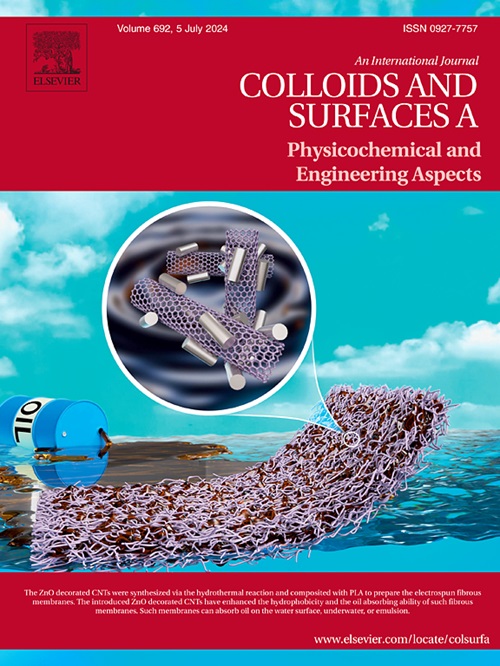High-performance hybrid superhydrophobic-hydrophilic substrates and their application in trace detection of antibiotics
IF 5.4
2区 化学
Q2 CHEMISTRY, PHYSICAL
Colloids and Surfaces A: Physicochemical and Engineering Aspects
Pub Date : 2025-06-24
DOI:10.1016/j.colsurfa.2025.137587
引用次数: 0
Abstract
Superhydrophobic (SHB) SERS substrates offer a simple and efficient solution for trace detection of substances in water by concentrating the analytes in a small area. However, the preparation of highly stable and durable SHB substrates is still a challenge. In this work, hybrid superhydrophobic-hydrophilic (SHB-HL) substrates were prepared through picosecond laser direct writing technology coupled with a chemical surface modification method. It was revealed that the solutes (i.e., noble metal nanoparticles or target molecules) in a droplet are concentrated into the small HL region with almost no loss. By mixing the antibiotic solutions with Au-nanorod colloid in an optimized volume ratio of 7:1 and dropping the mixed droplet onto the SHB-HL substrates, high SERS detection sensitivity (with the LODs of 4.6 ×10−8 M for levofloxacin hydrochloride and 1.68 ×10−9 M for metronidazole) and excellent detection reproducibility (RSD<10 %) were achieved, even with a portable Raman spectrometer. A strong linear correlation between the logarithm of SERS intensity and the logarithm of antibiotic concentration was observed, indicating good quantitative detection capability of our SHB-HL substrates. Remarkably, this kind of substrate maintained > 88 % SERS activity after 60 days storage, demonstrating excellent time durability. This work can be expanded to trace detection of various substances in water and has potential applications in environmental science and biomedicine.
高性能超疏亲水杂化底物及其在抗生素痕量检测中的应用
超疏水(SHB) SERS底物通过在小区域内浓缩分析物,为水中痕量物质的检测提供了一种简单有效的解决方案。然而,制备高度稳定和耐用的SHB衬底仍然是一个挑战。本文采用皮秒激光直写技术结合化学表面修饰法制备了超疏水-亲水性(SHB-HL)杂化衬底。结果表明,液滴中的溶质(即贵金属纳米颗粒或靶分子)几乎没有损失地集中在小HL区。通过将抗生素溶液与金纳米棒胶体以7:1的最佳体积比混合,并将混合液滴滴在SHB-HL底物上,获得了高的SERS检测灵敏度(盐酸左氧氟沙星的lod为4.6 ×10−8 M,甲硝唑的lod为1.68 ×10−9 M)和出色的检测重现性(RSD<10 %),即使使用便携式拉曼光谱仪也是如此。SERS强度的对数与抗生素浓度的对数呈较强的线性相关,表明我们的SHB-HL底物具有良好的定量检测能力。值得注意的是,这种底物在储存60天后保持了>; 88 %的SERS活性,表现出优异的时间耐久性。这项工作可以扩展到水中各种物质的痕量检测,在环境科学和生物医学方面具有潜在的应用前景。
本文章由计算机程序翻译,如有差异,请以英文原文为准。
求助全文
约1分钟内获得全文
求助全文
来源期刊
CiteScore
8.70
自引率
9.60%
发文量
2421
审稿时长
56 days
期刊介绍:
Colloids and Surfaces A: Physicochemical and Engineering Aspects is an international journal devoted to the science underlying applications of colloids and interfacial phenomena.
The journal aims at publishing high quality research papers featuring new materials or new insights into the role of colloid and interface science in (for example) food, energy, minerals processing, pharmaceuticals or the environment.

 求助内容:
求助内容: 应助结果提醒方式:
应助结果提醒方式:


